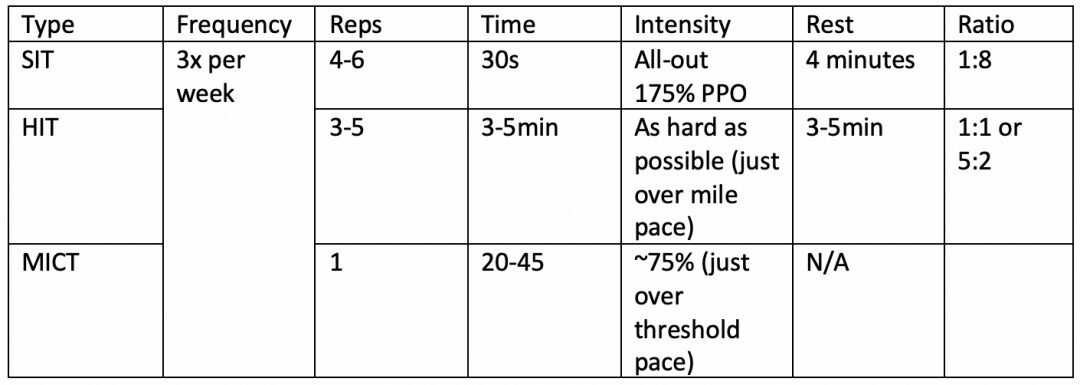What is the best way to train VO2max?
Introduction After determining VO2max, the next step is to create a training plan to improve VO2max and other aspects of fitness, (i.e. efficiency and threshold). There are a variety of different training interventions that can augment maximal oxygen uptake. These modalities include sprint interval training (SIT), high intensity interval training (HIT), and medium intensity continuousContinue reading "What is the best way to train VO2max?"

Introduction
After determining VO2max, the next step is to create a training plan to improve VO2max and other aspects of fitness, (i.e. efficiency and threshold). There are a variety of different training interventions that can augment maximal oxygen uptake. These modalities include sprint interval training (SIT), high intensity interval training (HIT), and medium intensity continuous training (MICT). Typically, people pose the question of which one is the best. The answer is, it depends on a number of different things such as training status (how trained you are), if you have done SIT, HIT, or MICT recently, and just overall how likely you are to stick to the training (i.e. push yourself while working out). Luckily, many scientists have completed loads of research regarding the different training modalities and how they can affect fitness. This allows for a study of studies to be completed, also known as a meta-analysis. These papers aim to combine research to test if what is being tested is repeatable in different environments. Below is a brief summary of the benefits that should be expected from each type of training. Overall, through proper training one should expect to increase their VO2max between 0.2 – 0.8 L/min.
What does the literature say?
One meta-analysis looking at HIT and MICT determined that high intensity interval training with work to rest ratios of 1:1 or 5:2 completed for 6-13 weeks resulted in an increase of VO2max by 0.5 L/min (95% CI of 0.43 to 0.60 L/min). Furthermore, this study confirmed that MICT is also beneficial for augmentation of VO2max, albeit, to a lower extent than HIT. In another meta-analysis looking at sprint interval training and its effect on maximal oxygen uptake the authors concluded that sprint interval training (SIT) resulted in an increase to relative VO2max of 3.6 ml/kg/min (~8%). An 8% increase is a significant amount but seems to be lower than the improvements from HIT training. Table 1 summarizes the findings of these studies, and includes the best intensity, and rep schemes that were found.

If improving maximal oxygen uptake is the only goal of training, then it appears that, for most people, completing 3-5 reps of 3-5minutes as hard as possible with 3-5min rest could result in the largest improvement to VO2max (0.85 L/min increase). However, it should be cautioned that only trying to improve one variable (in this case maximal oxygen uptake) could limit the scope of other beneficial adaptations that could occur. Another thing to keep in mind is that this type of training can be VERY mentally challenging so the likelihood that someone adheres to a training plan that is purely this type of work is fairly low. Yet, in order to gain specific adaptations it’s important to follow a specific protocol for AT LEAST 3-4 weeks at a time. If you are trying to improve VO2max, I would recommend something like the following. Of the above training modalities start with the one you have done the LEAST. For example, I would choose MICT, then do that training 1-2 times per week. Days immediately before the workouts should be VERY EASY recovery, days after the workouts can be recovery days or if you are a trained athlete the workouts could be longer. Follow this training plan for 2-4 weeks, then substitute the MICT workouts for HIT style workouts. Repeat these workouts for 2-4 weeks then do SIT. Of course, a training plan should encompass things like strength training, proper warm-ups, mobility, etc. but this should be a good starting scaffolding for improving VO2max.
Summary
Meta-analyses have shown that SIT, HIT, and MICT are all adequate stimuli to improve VO2max. However, many of the studies conducted had participants follow a very arduous protocol of 3-5 workouts per week for 6-12 weeks. For most people who do not workout very often a lower stimulus of 1-2 workouts per week for 2-4 weeks should be enough change in intensity to elicit an increase in VO2max. Also, to keep things fresh, change the type of workout (i.e. SIT, HIT, or MICT) every 2-4 weeks. This will provide a new stimulus to the body on top of changing other farther reaching benefits of exercise.
